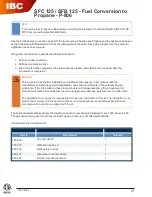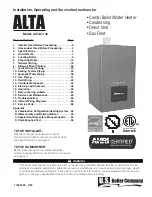
47
12.1 - CATEGORY
IV: Positive
pressure
condensing
An appliance that operates with a
positive vent static pressure with a
vent gas temperature that may cause
condensate production in the vent.
12.2 - CATEGORY
IV: Venting and air
piping systems
WARNING!!!
The vent
installation must be in
accordance with part
Venting
of Appliances
, of the latest
edition of the
National Fuel Gas
Code
, ANSI Z223.1/NFPA 54 or
section,
Venting Systems and
Air Supply for Appliances
, of
the CAN/CSA B149.1,
Natural
Gas and Propane Installation
code or applicable provisions
of the local building codes.
Improper venting can result
in excessive levels of carbon
monoxide which can result
in severe personal injury or
death!
WARNING!!!
All vent pipes
must be mechanically fixed.
Improper venting can result
in excessive levels of carbon
monoxide which can result
in severe personal injury or
death!
WARNING!!!
The exhaust
vent and the air inlet lines,
must be supported to prevent
sagging. To do this, use a
suitable pipe clamp to support
the lines. Pipe clamps shall
support the line every 3 ft (1
m). Pipe clamp shall be fixed
in correspondance of a wall
stud. Improper supporting can
result in excessive levels of
carbon monoxide which can
result in severe personal injury
or death!
WARNING!!!
Use of
cellular core PVC and CPVC
or Radel for venting system is
not allowed. Use of improper
materials can result in
excessive levels of carbon
monoxide which can result
in severe personal injury or
death!
Be sure to locate the heater such that
the vent and air piping can be routed
through the building and properly
terminated.
The vent/air piping lengths, routing
and termination method must all
comply with the methods and limits
given in Section 12.3.
12 - INSTALLATION - CATEGORY IV: Vent and combustion air
NOTICE!
The exhaust pipe must
be pitched a minimum of a 1/4 inch
per foot back to the heater (to allow
drainage of condensate).
NOTICE!
The vent system shall
be installed so as to prevent the
accumulation of condensate.
NOTICE!
Due to the high efficiency
of the heater it may discharge what
looks like white smoke especially
when the outside air temperature is
cold. This is a simply water vapor, a
purely natural phenomenon and not a
reason for concern.
This heater requires a special vent
system, designed for pressurized
venting.
You must install air piping from
outside to the heater air intake. The
resultant installation is Direct Vent
(sealed combustion).
The heater is to be used for either
Direct Vent installation or for
installation using room combustion
air. When room air is considered, see
Section 12.9.
Vent and air must terminate near one
another and may be vented vertically
through the roof or out a side wall,
unless otherwise specified. You may
use any of the vent/air piping methods
from Figure 12-1 to Figure 12-6. Do
not attempt to install this heater using
any other means.
WARNING!!!
DO NOT mix
components from different
systems. The vent system
could fail, causing leakage of
flue products into the living
space. Use only approved
materials listed on Figures 12-7
and 12-8. Improper materials
or mixing materials can result
in excessive levels of carbon
monoxide which can result
in severe personal injury or
death!
Содержание Esteem 399
Страница 3: ...3 SAFETY INSTRUCTIONS ...
Страница 5: ...5 SAFETY INSTRUCTIONS ...
Страница 112: ...112 17 MAINTENANCE ...
Страница 116: ...116 19 SPARE PARTS Spare parts ...
Страница 135: ......
















































